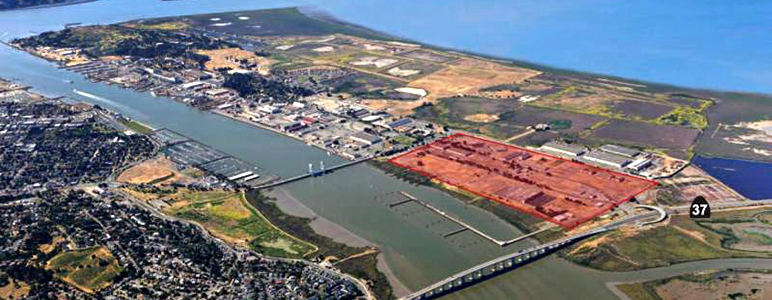


The City of Oakland’s reputation as a progressive city working toward a clean energy future would have been seriously compromised if plans to build a coal export facility on the old Oakland Army Base had gone forward (see: Coal Exports from Oakland's Ports, Bad Business). The votes on coal are in, and the Oakland City Council has moved unanimously to ban coal shipments. Two similarly minded bills – Senate Bill (SB) 1277 and SB 1279 – are making their way through the California Legislature, bolstering the city council vote.
Meanwhile, as reported by The New York Times, in Washington State, the United States Army Corps of Engineers has denied a permit for a coal terminal planned 90 miles north of Seattle on the grounds that it would endanger wildlife – shutting down another potential route off of the West Coast. Coal, it seems, has no clear route to the sea and therefore no access to the last markets still demanding such a dirty fuel.
Prioritizing a clean workforce
In contrast, at Mare Island in the nearby City of Vallejo (photo above), eyes are on the future. City officials are seeking to secure a deal to build a manufacturing facility for a growing electric vehicle (EV) company, Faraday Future. This essentially represents the exact opposite type of investment than coal, combining good governance with a progressive policy focused on innovation – despite looming fiscal concerns and challenges faced by the city.
While Vallejo’s actions are bold, they are calculated. It is widely recognized that clean energy technologies need a growing and modern workforce. Both the solar and energy storage industries are seeing explosive job growth over the last few years (see: Local Leaders Discuss Jobs, Clean Energy & Public Participation). Seeking investments in clean technology like EVs aligns with state manufacturing policy, innovation best practices, Vallejo’s redevelopment needs and clean energy policy.
Policies support EVs
Fundamentally, expanding EV manufacturing capacity is a workforce development policy. Once operational, this facility will pull a wide range of talent and workers at all levels from across the Bay Area, including the surrounding local communities in Vallejo. Auto manufacturing has traditionally provided stable, quality jobs with good pay, both in direct manufacturing and up and down the supply chain. The state’s Zero Emission Vehicle (ZEV) Action Plan looks to create lasting, wide-scale demand for EVs long into the future, so this looks like a good bet. As such, the Mare Island facility creates an opportunity to “lift all boats” in the area. This is fundamentally consistent with the state’s goals in leading the ZEV revolution.
Driven by innovation
This facility will be in the middle of the wider national transportation revolution. California’s decades-long push to reduce tailpipe emissions has made transportation electrification a real, even superior option to fossil fuel combustion. As Californians, and now the nation, put more and more EVs on the road, they are building on and fostering further innovations like massive advancements in battery technology, the success of transportation network companies and even the construction of high-speed rail and public transit systems. Nationally, the U.S. Department of Transportation launched the Future of Transportation: Safety, Opportunity and Innovation series and the White House announced a major Smart Manufacturing initiative.
An EV manufacturing facility supports and benefits from this innovation by utilizing a dynamic workforce well-positioned to catch any number of waves across this rapidly evolving transportation space.
Out with the old
The former military installation on Mare Island, like the old Oakland Army Base, is up for reuse and revitalization by the local community. From our perspective, the ideal outcome of this process would support increased economic activity and modern infrastructure. State-of-the-art, energy-efficient manufacturing facilities that replace outmoded buildings across the island will leverage the base’s vast infrastructure and significant rail and shipping connections to provide access to supply chain companies and to markets around the world. And all of this can be accomplished without plowing under farmland or open spaces.
Design in renewables
The new buildings can be designed to manage and produce as much energy as they use, incorporating distributed energy resources like solar, energy storage, managed vehicle charging and demand response in addition to energy efficiency measures. With abundant solar and wind resources, Mare Island itself can act as a beacon, putting clean energy and resiliency in service of the future smart grid while simultaneously enhancing the functioning of the facilities operating there.
Cities take note
As the negotiations between Faraday Future and Vallejo progress, California continues to seek policies that will drive the uptake of EVs in the market and promote still more innovation. Both will require a dynamic, ambitious green workforce with a variety of high tech, manufacturing and support skills.
Triggered by the push toward innovation, demand for this “workforce of the future” will only increase as the state pursues expanded renewable energy benchmarks, meets its building energy efficiency goals and places hundreds of thousands of EVs on the state’s roadways.
Vallejo’s pursuit of a partnership with Faraday Future is a smart maneuver to secure their place in the future clean energy economy, something which coal can never do for any city. Oakland and surrounding Bay Area communities should take note.

